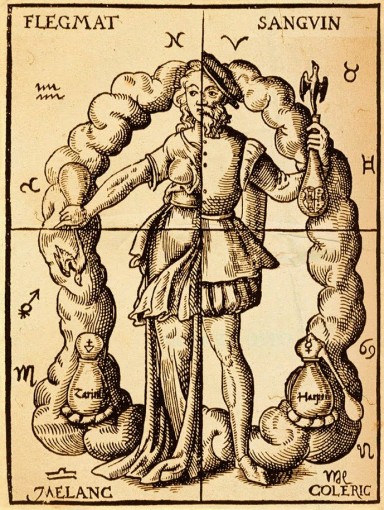Embodied Humors – full article
Embodied Humoral Work for Actors
The history of the body is ultimately a history of ways of inhabiting the world. – Shigehisa Kuriyama, The Expressiveness of the Body and the Divergence of Greek and Chinese Medicine (1999)
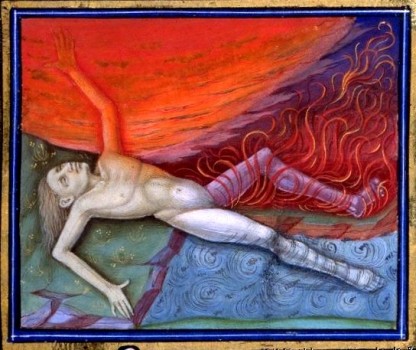
Since 2006 I have been developing Embodied Humors work: through research and a number of workshops in New York and Boston with actors and directors, I have built a training, a progression of exercises, that explores how we might physically embody the humoral theory that is central to philosophical/medical thought from the Greeks through Shakespeare and other Elizabethan playwrights. A vestige of this understanding lives on in our current language — while “humorous” has changed locations from one of many feelings to an amusing one, we still say someone is “melancholic” or “sanguine” about something, or has a “choleric personality” and I have come across “phlegmatic” in a newspaper article or two to describe someone’s actions.
But what could it mean, for example, to be someone of a melancholic temperament? As an actor, how could my very being—my physical incarnation, breath, way of seeing the world, my shape of thought—be filled with that humor? The answers are neither entirely descriptive nor psychological in the colloquial sense.
While particularly suited to practitioners of classical theater, Embodied Humors work can enlarge the performative range of all actors. The goal is to inhabit this ancient thought as living information, giving additional dimensionality to actor’s work.
Humoral Theory
To begin at the beginning: the elements from which the world is made are air, fire, water and earth; the seasons from which the year is composed are spring, summer, winter and autumn, the humours from which animals and humans are composed are yellow bile, blood, phlegm and black bile. – Galen (131-200 AD), On the Humours
 The Greeks, building on even older thought, understood the cosmos to be made of four basic energies that were seen in earth, air, fire and water. These same energies manifested in everything – the four seasons, periods of the day, food, life cycles, colors, metals, and the planets. Inside the human body the four energies were the four fluids – black bile, phlegm, blood, and yellow bile. Few people were able to maintain the ideal of a balance between the four fluids, and instead, were surfeited more by one. This was known as their humoral temperament, or “complexion” (referring to an interior condition rather than skin tone): Melancholic, Phlegmatic, Choleric, and Sanguine.
The Greeks, building on even older thought, understood the cosmos to be made of four basic energies that were seen in earth, air, fire and water. These same energies manifested in everything – the four seasons, periods of the day, food, life cycles, colors, metals, and the planets. Inside the human body the four energies were the four fluids – black bile, phlegm, blood, and yellow bile. Few people were able to maintain the ideal of a balance between the four fluids, and instead, were surfeited more by one. This was known as their humoral temperament, or “complexion” (referring to an interior condition rather than skin tone): Melancholic, Phlegmatic, Choleric, and Sanguine.
God of His goodness, that is Creator of all things, hath ordained cures for mankind…for the sustentation and health of His loving creature mankind, which is only made equally of the four elements and qualities of the same. And when any of these four abound or hath more dominion the one than the other, it constraineth the body of man to great diseases for the which the Eternal God have given…all manner of herbs to cure and heal. – Anonymous, The Great Herbal (1526)
Additionally, since humans were in direct relationship to the outside world, a person’s humoral state was seen to be influenced by diet, time of life, season of the year, and life experiences.
In her treatise Causes and Cures (c. 1150), Hildegard von Bingen referred to the energies, or elements, as being “the fabric of the human body…. They are diffused and active throughout the body…and at the same time they are spread throughout the world and work upon it.” The four energies in the elements were understood to be directly connected to the inner workings of human beings and their health, as well as their actions. Humoral theory was part of a world view in which the human being was a microcosm of a larger whole.
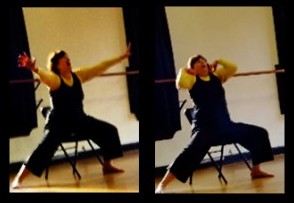
“All bodies are Transpirable and Trans-fluxible,” wrote Helkiah Croke, a medical practitioner, in 1615, “so open to the ayre as that it may passe and re-passe through them.” In the Embodied Humors workshops, actors develop an awareness of permeability, a constant exchange between the inside and the outside. Opening ourselves to this permeability encourages a greater responsiveness to the natural world, which continually affects what happens inside us.
Starting with strong physical expression, we proceed to feel and take on the implications of the rhythm, shape, and qualities of the correspondences. This makes us conscious of the connections between our experience, thought, and language. We have the experience of being “consumed” or “breezy” or “grounded” or “flowing.” Encounters with the elements produce a psychophysical melding. Following a workshop one student commented, “I was sad to lose my thought…when I went to air.” Another said, “I felt moved around as water.” They were identifying with the element, and were able to articulate psychological responses from there.
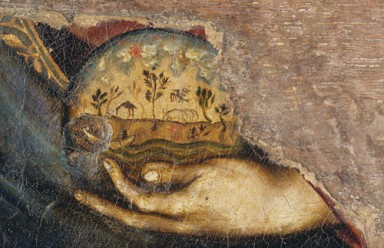 In Embodied Humor work we reconstruct a worldview through which we may then create characters’ actions, thoughts, and traits. We add depth to characterization, providing tools for discovering the rhythm, density, thought pattern and direction of a character, and enhancing what the actor will develop in rehearsal. Though contemporary audiences may not have knowledge of the humoral system, they will experience actors’ embodied connection to the text and character as they communicate a classical understanding of the world.
In Embodied Humor work we reconstruct a worldview through which we may then create characters’ actions, thoughts, and traits. We add depth to characterization, providing tools for discovering the rhythm, density, thought pattern and direction of a character, and enhancing what the actor will develop in rehearsal. Though contemporary audiences may not have knowledge of the humoral system, they will experience actors’ embodied connection to the text and character as they communicate a classical understanding of the world.
And these same thoughts people this little world,
In humours like the people of this world,
For no thought is contented. – Shakespeare, Richard II (1597)
Playwrights in both the classical and Elizabethan periods shared with their audiences a knowledge of and belief in the humoral system. Characters’ actions were governed by the flow of their humoral bias; natural phenomena could also reflect the inner world of a character. These details contributed to the audience’s understanding and experience of the play. “Yet from the same winds still/These blasts of soul hold her,” Sophocles writes of Antigone: more than a metaphor, the wind is the same – the external winds mirror the blasts of her soul.
Historical Beginnings
Sumerian and Egyptian scholars may have been the first to codify humoral theory. Hippocrates (460-370 BC) later connected human behavior to the four humors, departing from a belief in the gods’ complete control of health. Expanding on the ideas of Aristotle, Plato, and Empedocles, the Roman physician Galen made a connection between the elements and the four humoral fluids, articulating their basic properties and formulating the concept of temperaments. Islamic scholars further developed humoral knowledge, which was nearly forgotten in Europe during the medieval period—with the exception of individual healers and practitioners at monasteries.
Humors in the Renaissance
In Shakespeare’s time, humoral theory influenced every aspect of cultural life. Scientists understood the human body as being divided into three realms: the lower body was the realm of appetite—sex, procreation, aggression—ruled by the liver; the middle realm, of passion, was ruled by the heart; and the upper realm—governing memory, imagination, reason, will, and spiritual faculties—by the brain. Life was the constant movement between these regions. The most desirable disposition (or complexion) was one that balanced the four humors.
Dramatic situations arose when characters tilted towards an abundance of one or another humor; incorrect habits of diet or sudden traumatic events could alter a character’s “native hue.” Balance could be restored both from within and without, by means of a variety of cures, including prayer, action, diet, sleep, exercise, herbs, remedies, change of venue, and blood-letting.
Spenser, Jonson, and Shakespeare all refer to the humors in their work. “As in natural bodies, so likewise in minds,” wrote Jonson: “there is not disease or distemperature but is caused either by some abounding humor or perverse affection.” Shakespeare provided his audience with many overt references to the humors, which were clues to his characters’ behaviors and to the actions of his plays. Romeo, for example, has become temporarily melancholic following his break-up with Rosaline at the beginning of Romeo and Juliet: he is described as “leaden,” the metal associated with melancholy. His mates urge him to go with them to a dance: the distraction they hope will change his current humoral state. And who of us hasn’t tried something similar, dragging a friend in need of cheering up to a dance or a concert?
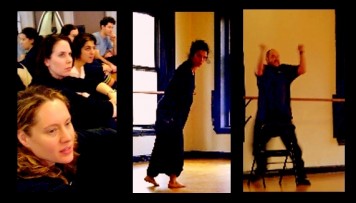 “Oh, for a muse of fire” sets the stage for a world of choleric energy; Henry V is about battle and soldiers, who typically demonstrated the choleric temperament. Cassius’
“Oh, for a muse of fire” sets the stage for a world of choleric energy; Henry V is about battle and soldiers, who typically demonstrated the choleric temperament. Cassius’
“lean and hungry look” indicated to an Elizabethan audience that this character has a choleric temperament. Fire also figures in Taming of the Shrew, which is now considered a problematic play, but when we read with humoral understanding Petruchio’s decision to “fight fire with fire,” we understand this as his homeopathic cure to adjust Kate’s culturally inappropriate temperament and choleric behavior. In fact, much of the play—the foods, the activities, the temperaments—are of a choleric nature.
I think, therefore I am
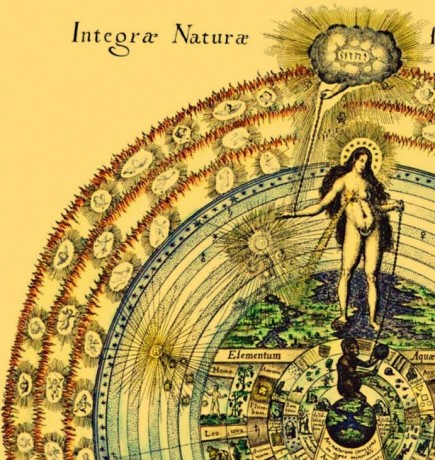 With the development of empirical science, Europeans became more interested in smaller particles of understanding. They began to believe in minute organisms attacking humans from the outside—viruses, bacteria—rather than health and illness as the flux of an internal/external balance. Dissections were performed in order to understand the physical mechanisms of the human body. Western medicine began to divide into specialized areas, with the study of philosophy and psychology—the mental realms—gradually becoming separated from the material fabric of the body.
With the development of empirical science, Europeans became more interested in smaller particles of understanding. They began to believe in minute organisms attacking humans from the outside—viruses, bacteria—rather than health and illness as the flux of an internal/external balance. Dissections were performed in order to understand the physical mechanisms of the human body. Western medicine began to divide into specialized areas, with the study of philosophy and psychology—the mental realms—gradually becoming separated from the material fabric of the body.
As Charles Taylor describes, in Sources of the Self (1989), the revolution in worldview that characterizes the early modern era, the cosmos is no longer seen as the embodiment of meaningful order which can define the good for us. And this move is brought about by our coming to grasp this world as mechanism. We…escape the confused experience of everyday sensation by seeing the causal-functional connections between body-state and idea. We demystify the cosmos as a setter of ends by grasping it mechanistically and functionally as a domain of possible means. Gaining insight into the world as mechanism is inseparable from seeing it as a domain of potential instrumental control.
Western thinkers began to identify the mind and the body as two separate entities, the mind containing all the higher faculties and the body (now an “it”) with its interlocking systems—respiratory, circulatory—a lesser partner in the human being. People started to see themselves as independent, autonomous individuals, their purpose defined by what was in them, and what they thought, rather than by their participation in a larger plan. Descartes objectified himself as an individual, separate from the world.
While we have gained an enormous amount of specific knowledge since the age of enlightenment, we have lost, as David Abram reminds us, the concept of our bodies as “the sensuous aspect of the mind.” We no longer understand ourselves as being in the world, but see ourselves instead as standing on the earth.
Enduring Interrelationships
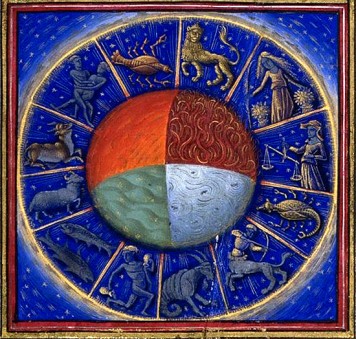 Of course many world traditions continued to maintain the connected viewpoint even as European thinkers were rejecting it. Native American and shamanic cultures worldwide have traditions of the four winds and the four directions with which they interact. Ancient medical practices investigate to this day the connections betweens elements and health: Chinese medicine has a fifth direction, ether, to signify an energy beyond the world; the Ayurvedic tradition reduces the types to three. Astrology still speaks about the human character in terms of influences: the energies of the planets and their associations with the four elements (air signs, earth signs, etc.) are all residues of a humoral understanding of the world. Philosophy and psychology, even as practiced by Westerners, use types of temperament to describe human nature; among those who have created circles and divided the old humoral energies into extrovert and introvert are Kant, Jung, Adler, Steiner, Fromm, and Eysenck.
Of course many world traditions continued to maintain the connected viewpoint even as European thinkers were rejecting it. Native American and shamanic cultures worldwide have traditions of the four winds and the four directions with which they interact. Ancient medical practices investigate to this day the connections betweens elements and health: Chinese medicine has a fifth direction, ether, to signify an energy beyond the world; the Ayurvedic tradition reduces the types to three. Astrology still speaks about the human character in terms of influences: the energies of the planets and their associations with the four elements (air signs, earth signs, etc.) are all residues of a humoral understanding of the world. Philosophy and psychology, even as practiced by Westerners, use types of temperament to describe human nature; among those who have created circles and divided the old humoral energies into extrovert and introvert are Kant, Jung, Adler, Steiner, Fromm, and Eysenck.
In the last fifteen years or so, the work of cognitive scientists and neuroscientists has begun to dissolve once again the wall that has been erected between the inside and the outside. Embodied cognition brings the intelligence of the body to the reactions of the mind. Environmentalists have begun to argue for the implications to the worldbeing of the individual’s action; philosophers and neurologists are reexamining the relation of the macrocosm and the microcosm. Paradoxically, the study of ancient humoral theory provides us with a language to re-member and re-embody the formerly sundered self.
As actors on the stage, by inhabiting more fully our elemental connections, we can provide our audience with a more dimensional experience of our human condition.
© Merry Conway, 2011. All rights reserved
